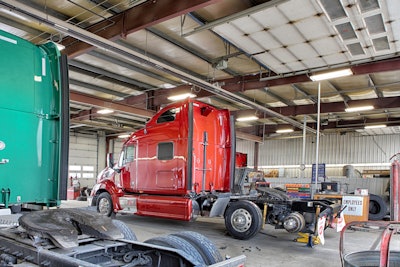
Every fleet wants to keep its vehicles on the road as much as possible. While 100% utilization is not possible (trucks have to be taken off the road for regular maintenance), maximizing uptime is key for all fleets.
The good news is that there are some simple things fleets can do to get as close to 100% as possible.
[Related: Three ways to reduce operating costs]
1. As odd as this may sound, the number one way to ensure uptime is by measuring downtime and making it very visible. One good way to do this is to create a dashboard that is visible in the shop, to senior leadership and to the customer.
When a truck comes in, the technician or foreman enters basic information about the piece of equipment, what is wrong with it and the repair plan and the clock starts ticking. Everyone can see how much time the repair is taking. You can set a threshold limit so that when a repair exceeds a certain amount of time, the dashboard turns red letting everyone know that the situation is critical.
Or you can have it first turn yellow when the repair is getting close to exceeding the time typically allotted. That will give you the opportunity to take action before the situation becomes critical.
2. Set thresholds for escalating parts procurement beyond your normal practice. When a piece of equipment goes down, you are at the mercy of your parts supplier to get you the part(s) needed to complete the repair.
Establish a timeframe where you will take more aggressive action to get a part if your regular vendor cannot get it to you. That could include putting out an all-points bulletin to other locations (for multi-location operations) to see if another location has one in stock, calling on the OEM for support if the local dealer cannot help you, engaging your warranty department to see if there is a pattern of this type of failure and how it was solved previously, and/or engaging with your purchasing director who may have suggestions for substitute parts.
3. Make sure drivers are vigilant in completing their pre-trip and post-trip inspections. If done properly, these inspections can help you see a problem developing before the unit goes on the road. If you nip it in the bud, you can prevent a breakdown and road call.
One good way to keep drivers from just going through the motions is to hide coupons in certain areas of the truck that can only be found if the driver actually does their PM. The coupon could be for a sandwich at a local restaurant.
There are also technology solutions that walk the driver through the inspection in a specific order with times assigned to how long the driver should spend at each location on the truck. That technology comes with a price tag, but it might be a good investment if it keeps trucks on the road.
4. In addition to driver inspections, institute high-level lot walks where you walk through the lot to check on vehicles. You can spot things like flat tires, oil on the ground, broken headlights and other highly visible issues that you can take care of before sending the truck out on the road. You can even add a weekly lot walk with the fleet manager, taking a little more time to walk around to spot obvious problems.
5. Your preventive maintenance process is as important as the pre-trip and post-trip inspection in keeping trucks in good operating condition. Make sure each asset is on the proper PM schedule and that you track PM compliance. You might consider adding a PM quality check program in which the shop foreman periodically spot checks PMs to make sure the tech is doing more than going through the motions. During the quality check, look at things like grease fittings, fluid levels, air pressure, seals, etc.
While there is no way to eliminate downtime, following these five simple steps will go a long way to reducing the amount of time your trucks are down.
Gino Fontana is Vice President Operations Berkeley Division & Puerto Rico at Transervice Logistics Inc. His operational expertise emphasizes efficiency, cost savings, superior quality, people management skills and process improvement. He has more than 35 years’ experience in the transportation and logistics industry with both operational and sales experience.









